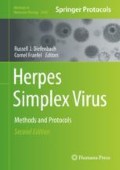Abstract
Herpes viruses are important human pathogens that cause a wide range of diseases from skin lesions to malignancies. Protein interactions drive many cellular events and mediate a number of biochemical pathways leading to different physiological outcomes. Protein interactions between viral proteins and host proteins play significant roles in viral entry, replication and suppression of host-immune responses. Therefore, the study of virus–host interactions promises significant advancement in designing therapeutics to control infection and disease. Various approaches are employed in the field to study and identify protein interactions that combine affinity purification along with different detection methods. Advancements in protein purification and high-throughput detection methods have resulted in an unprecedented level of discovery. Here we detail the use of proximity dependent biotinylation (BioID) as a means of affinity purification coupled with the use of LC-MS/MS for the detection and identification of protein–protein interaction networks.
Access this chapter
Tax calculation will be finalised at checkout
Purchases are for personal use only
References
de Boer E, Rodriguez P, Bonte E, Krijgsveld J, Katsantoni E, Heck A, Grosveld F, Strouboulis J (2003) Efficient biotinylation and single-step purification of tagged transcription factors in mammalian cells and transgenic mice. Proc Natl Acad Sci U S A 100(13):7480–7485. https://doi.org/10.1073/pnas.1332608100
Meckes DG (2014) Affinity purification combined with mass spectrometry to identify herpes simplex virus protein-protein interactions. Methods Mol Biol 1144:209–222. https://doi.org/10.1007/978-1-4939-0428-0_14
Zhao X, Li G, Liang S (2013) Several affinity tags commonly used in chromatographic purification. J Anal Methods Chem 2013:581093. https://doi.org/10.1155/2013/581093
Kimple ME, Sondek J (2004) Overview of affinity tags for protein purification. Curr Protoc Protein Sci. Chapter 9:Unit 9.9. https://doi.org/10.1002/0471140864.ps0909s36
Kimple ME, Brill AL, Pasker RL (2013) Overview of affinity tags for protein purification. Curr Protoc Protein Sci 73.:Unit 9.9. https://doi.org/10.1002/0471140864.ps0909s73
Roux KJ, Kim DI, Raida M, Burke B (2012) A promiscuous biotin ligase fusion protein identifies proximal and interacting proteins in mammalian cells. J Cell Biol 196(6):801–810. https://doi.org/10.1083/jcb.201112098
Fairhead M, Howarth M (2015) Site-specific biotinylation of purified proteins using BirA. Methods Mol Biol 1266:171–184. https://doi.org/10.1007/978-1-4939-2272-7_12
Miyagawa-Yamaguchi A, Kotani N, Honke K (2014) Expressed glycosylphosphatidylinositol-anchored horseradish peroxidase identifies co-clustering molecules in individual lipid raft domains. PLoS One 9(3):e93054. https://doi.org/10.1371/journal.pone.0093054
Li XW, Rees JS, Xue P, Zhang H, Hamaia SW, Sanderson B, Funk PE, Farndale RW, Lilley KS, Perrett S, Jackson AP (2014) New insights into the DT40 B cell receptor cluster using a proteomic proximity labeling assay. J Biol Chem 289(21):14434–14447. https://doi.org/10.1074/jbc.M113.529578
Rees JS, Li XW, Perrett S, Lilley KS, Jackson AP (2015) Protein neighbors and proximity proteomics. Mol Cell Proteomics 14(11):2848–2856. https://doi.org/10.1074/mcp.R115.052902
Arnau J, Lauritzen C, Petersen GE, Pedersen J (2006) Current strategies for the use of affinity tags and tag removal for the purification of recombinant proteins. Protein Expr Purif 48(1):1–13. https://doi.org/10.1016/j.pep.2005.12.002
Kim DI, Roux KJ (2016) Filling the void: proximity-based labeling of proteins in living cells. Trends Cell Biol 26(11):804–817. https://doi.org/10.1016/j.tcb.2016.09.004
Rider MA, Cheerathodi MR, Hurwitz SN, Nkosi D, Howell LA, Tremblay DC, Liu X, Zhu F, Meckes DG (2018) The interactome of EBV LMP1 evaluated by proximity-based BioID approach. Virology 516:55–70. https://doi.org/10.1016/j.virol.2017.12.033
Kim DI, Jensen SC, Noble KA, Kc B, Roux KH, Motamedchaboki K, Roux KJ (2016) An improved smaller biotin ligase for BioID proximity labeling. Mol Biol Cell 27(8):1188–1196. https://doi.org/10.1091/mbc.E15-12-0844
Sardiu ME, Cai Y, Jin J, Swanson SK, Conaway RC, Conaway JW, Florens L, Washburn MP (2008) Probabilistic assembly of human protein interaction networks from label-free quantitative proteomics. Proc Natl Acad Sci U S A 105(5):1454–1459. https://doi.org/10.1073/pnas.0706983105
Selbach M, Mann M (2006) Protein interaction screening by quantitative immunoprecipitation combined with knockdown (QUICK). Nat Methods 3(12):981–983. https://doi.org/10.1038/nmeth972
Miteva YV, Budayeva HG, Cristea IM (2013) Proteomics-based methods for discovery, quantification, and validation of protein-protein interactions. Anal Chem 85(2):749–768. https://doi.org/10.1021/ac3033257
Perez-Hernandez D, Gutiérrez-Vázquez C, Jorge I, López-Martín S, Ursa A, Sánchez-Madrid F, Vázquez J, Yáñez-Mó M (2013) The intracellular interactome of tetraspanin-enriched microdomains reveals their function as sorting machineries toward exosomes. J Biol Chem 288(17):11649–11661. https://doi.org/10.1074/jbc.M112.445304
Warden C, Tang Q, Zhu H (2011) Herpesvirus BACs: past, present, and future. J Biomed Biotechnol 2011:16. https://doi.org/10.1155/2011/124595
Richards AL, Sollars PJ, Smith GA (2016) New tools to convert bacterial artificial chromosomes to a self-excising design and their application to a herpes simplex virus type 1 infectious clone. BMC Biotechnol 16(1):64–64. https://doi.org/10.1186/s12896-016-0295-4
Acknowledgments
Special thanks to Mark Rider initiating the use of the BioID method in the lab. The method described in this chapter was developed with the support of grants from the National Institutes of Health (CA204621 and CA188941) awarded to D.G.M.
Author information
Authors and Affiliations
Corresponding author
Editor information
Editors and Affiliations
Rights and permissions
Copyright information
© 2020 Springer Science+Business Media, LLC, part of Springer Nature
About this protocol
Cite this protocol
Cheerathodi, M.R., Meckes, D.G. (2020). BioID Combined with Mass Spectrometry to Study Herpesvirus Protein–Protein Interaction Networks. In: Diefenbach, R., Fraefel, C. (eds) Herpes Simplex Virus . Methods in Molecular Biology, vol 2060. Humana, New York, NY. https://doi.org/10.1007/978-1-4939-9814-2_19
Download citation
DOI: https://doi.org/10.1007/978-1-4939-9814-2_19
Published:
Publisher Name: Humana, New York, NY
Print ISBN: 978-1-4939-9813-5
Online ISBN: 978-1-4939-9814-2
eBook Packages: Springer Protocols

